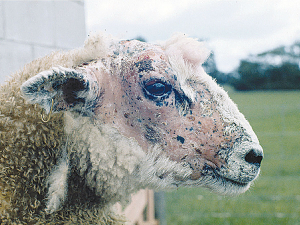2024/25 Dairy Statistics: NZ dairy farmers boost production with fewer cows
According to the New Zealand Dairy Statistics 2024/25 report, New Zealand dairy farmers are achieving more with fewer cows.
 Until recently, Sporidesmin, the toxin responsible for FE, was thought to be made by the fungus Pseudopithomyces chartarum.
Until recently, Sporidesmin, the toxin responsible for FE, was thought to be made by the fungus Pseudopithomyces chartarum.
A breakthrough in the understanding of Facial Eczema (FE) in livestock could bring New Zealand closer to reducing the disease’s impact.
Until recently, Sporidesmin, the toxin responsible for FE, was thought to be made by the fungus Pseudopithomyces chartarum.
However, researchers from AgResearch, Manaaki Whenua, Beef + Lamb New Zealand (B+LNZ) and Livestock Improvement Corporation (LIC) have shown that few Pseudopithomyces chartarum strains appear capable of making sporidesmin, and a new species, Pseudopithomyces toxicarius, is the primary sporidesmin producer, providing a clearer understanding of the disease’s causes, and paving the way for more effective control strategies.
FE has cost the New Zealand economy an estimated $332 million annually.
Dan Brier, B+LNZ’s general manager of farming excellence, says FE has been a long-standing challenge for farmers.
“This research is a vital step toward understanding the fungus and ultimately eliminating its impact,” Brier says.
“Identifying the species responsible gives us a clearer foundation for developing more accurate diagnostic tools and effective management practices. This collaboration highlights the importance of working together to solve this issue, and we’re proud to contribute to this breakthrough,” he says.
“Bringing together farmer-led organisations and researchers is key to delivering practical outcomes that truly make a difference on the ground. By combining real-world farming experience with scientific expertise, we ensure that research is not just theoretical but directly applicable to the challenges farmers face every day," adds Brier.
Dr Bevin Weir, senior scientist at Manaaki Whenua says the findings are the result of years of hard work and dedication from research teams and the farming community.
“Identifying Pseudopithomyces toxicarius as the primary cause of Facial Eczema is a critical step forward and a testament to the commitment of everyone involved.”
As B+LNZ’s Eliminating Facial Eczema Impacts (EFEI) programme continues its work, this collaborative research from Beef + Lamb New Zealand, AgResearch, Manaaki Whenua and LIC represents a crucial step in solving the challenges of Facial Eczema.
The National Wild Goat Hunting Competition has removed 33,418 wild goats over the past three years.
New Zealand needs a new healthcare model to address rising rates of obesity in rural communities, with the current system leaving many patients unable to access effective treatment or long-term support, warn GPs.
Southland farmers are being urged to put safety first, following a spike in tip offs about risky handling of wind-damaged trees
Third-generation Ashburton dairy farmers TJ and Mark Stewart are no strangers to adapting and evolving.
When American retail giant Cosco came to audit Open Country Dairy’s new butter plant at the Waharoa site and give the green light to supply their American stores, they allowed themselves a week for the exercise.
Fonterra chair Peter McBride says the divestment of Mainland Group is their last significant asset sale and signals the end of structural changes.